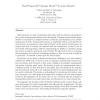4324 search results - page 826 / 865 » Online social networks |
CSUR
1999
13 years 7 months ago
1999
The Web can be naturally modeled as a directed graph, consisting of a set of abstract nodes (the pages) joined by directional edges (the hyperlinks). Hyperlinks encode a considerab...
RAS
2008
13 years 7 months ago
2008
Robot projects are often evolutionary dead ends, with the software and hardware they produce disappearing without trace afterwards. Common causes include dependencies on uncommon ...
CORR
2010
Springer
13 years 6 months ago
2010
Springer
The neighbourhood function NG(t) of a graph G gives, for each t ∈ N, the number of pairs of nodes x, y such that y is reachable from x in less that t hops. The neighbourhood fun...
WWW
2011
ACM
13 years 2 months ago
2011
ACM
In this paper, we study the problem of transfer learning from text to images in the context of network data in which link based bridges are available to transfer the knowledge bet...
WWW
2011
ACM
13 years 2 months ago
2011
ACM
The clustering coefficient of a node in a social network is a fundamental measure that quantifies how tightly-knit the community is around the node. Its computation can be reduce...

